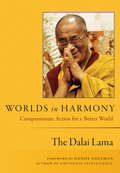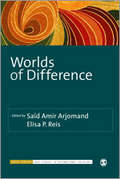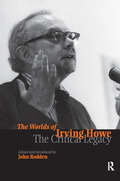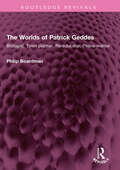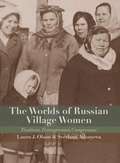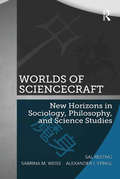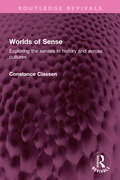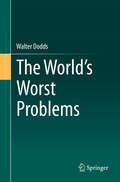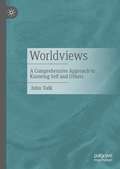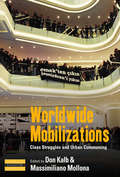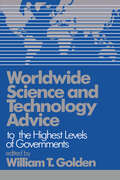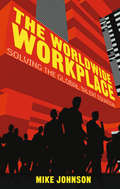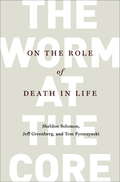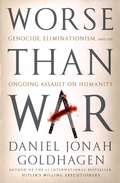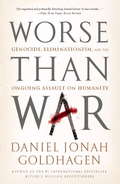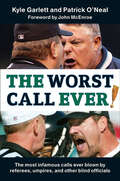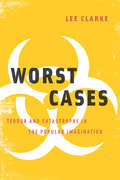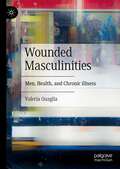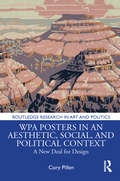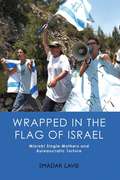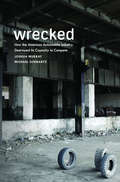- Table View
- List View
Worlds in Harmony: Compassionate Action for a Better World
by Daniel Goleman The Dalai LamaOne of the Dalai Lama's most striking qualities is his genuine interest in Western scientific and social thought. <P><P>He firmly believes that if Buddhism is to have relevance today, it must be flexible and dynamic, able to take in new ideas and adapt to new situations. In Worlds in Harmony, he combines timeless Buddhist teachings with modern Western psychological theory to address such diverse issues as environmental destruction, political oppression, the nature of anger, and the application of Buddhist principles in the West. Writing that insight is of no use unless it results in action, he offers new ways of being, thinking, and acting in the world that are based on equanimity and deep understanding. Worlds in Harmony is a timely source book on the practice of healing and compassionate action in daily life.
Worlds of Difference (SAGE Studies in International Sociology)
by Elisa P Reis Said ArjomandHow can differences be understood in social theory through comparisons, and how should social theory relate to regional studies to do so? This question has been prevalent within the sociological field for over a century, but is becoming increasingly important in a globalised age in which cultural borders are constantly challenged and rapidly changing. In this collection, Arjomand and Reis illuminate the importance of exploring spatial, cultural and intellectual differences beyond generalizations, attempting to understand diversity in itself as it takes shape across the world. With contributions from internationally renowned scholars, and a focussed emphasis upon sociological key themes such as modernization, citizenship, human rights, inequality and domination, this title provides a rich and convincing discussion that will add significant value to the ongoing debate about alternative modernities, diversity and change within the social sciences. Worlds of Difference constitutes an important and timely collection that will be of great inspiration for students and scholars alike.
Worlds of Irving Howe: The Critical Legacy
by John RoddenThe Worlds of Irving Howe: The Critical Legacy is a wide-ranging anthology of criticism devoted to the literary, cultural, and political work of the writer Irving Howe. The book offers a broad cross-section of critical and biographical writings about Howe. Collected here are assessments of Howe's work written by some of the most prominent intellectuals of the twentieth century, among them Lionel Trilling, Alfred Kazin, C. Vann Woodward, Robert Coles, Daniel Bell, Malcolm Cowley, and Arthur Schlesinger. The critical estimates of Howe's major books, collected here and framed by a major biographical introduction by John Rodden, constitute a sharply focused lens through which readers can re-evaluate the legacy of one of American's leading intellectuals and thereby understand the main issues of twentieth-century Anglo-American cultural history. Contributors: Lionel Trilling, Alfred Kazin, C. Vann Woodward, Newton Arvin, Charles Angoff, Edward Dahlberg, Isaac Rosenfeld, Richard Chase, H.D. Lasswell, Dennis Wrong, Michael Harrington, Christopher Lasch, Robert Coles, Daniel Bell, Malcolm Cowley, Arthur Schlesinger, Theodore Solotaroff, Clive James, Norman Podhoretz, Irving Kristol, and William Phillips, among others.
The Worlds of Patrick Geddes: Biologist, Town planner, Re-educator, Peace-warrior (Routledge Revivals)
by Philip BoardmanFirst published in 1978, The Worlds of Patrick Geddes is a study of Patrick Geddes’ thought and action, his relationships and his life, as someone who defied labelling and who was years ahead of his contemporaries. The work of Patrick Geddes (1854-1932) is coming to be more and more widely appreciated, as his ideas on many diverse subjects are being gradually assimilated into the mainstream of modern thought. Geddes has been confidently labelled as a biologist, town-planner, sociologist and educator; but he was all of these and more. This book will be of interest to students of biology, urban planning and sociology.
The Worlds of Russian Village Women
by Laura J. Olson Svetlana AdonyevaRussian rural women have been depicted as victims of oppressive patriarchy, celebrated as symbols of inherent female strength, and extolled as the original source of a great world culture. Throughout the years of collectivization, industrialization, and World War II, women played major roles in the evolution of the Russian village. But how do they see themselves? What do their stories, songs, and customs reveal about their values, desires, and motivations? Based upon nearly three decades of fieldwork, from 1983 to 2010,The Worlds of Russian Rural Womenfollows three generations of Russian women and shows how they alternately preserve, discard, and rework the cultural traditions of their forebears to suit changing needs and self-conceptions. In a major contribution to the study of folklore, Laura J. Olson and Svetlana Adonyeva document the ways that women’s tales of traditional practices associated with marriage, childbirth, and death reflect both upholding and transgression of social norms. Their romance songs, satirical ditties, and healing and harmful magic reveal the complexity of power relations in the Russian villages.
Worlds of ScienceCraft: New Horizons in Sociology, Philosophy, and Science Studies
by Sal Restivo Sabrina M. Weiss Alexander StinglA response to complex problems spanning disciplinary boundaries, Worlds of ScienceCraft offers bold new ways of conceptualizing ideas of science, sociology, and philosophy. Beginning with the historical foundations of civilization and progress, assumptions about the categories we use to talk about minds, identities, and bodies are challenged through case studies from mathematics, social cognition, and medical ethics. Offering innovative approaches to these issues, such as an integrated social brain-mind-body model and a critique of divisions between the natural and technological, this book provides novel conceptions of self, society and an emerging ’cyborg’ generation. From the micro level of brains and expanding all the way out to biopolitical civics, disciplinary boundaries are made permeable, emphasizing the increased need for interdisciplinary scholarship. By rejecting outdated and restrictive categories and classifications, new horizons in studies of science, technology, and medicine can be explored through the incorporation of feminist, international, and postmodern perspectives. A truly interdisciplinary examination of science and technology as cultural phenomena, Worlds of ScienceCraft will appeal to scholars and students of science and technology studies, as well as philosophers, historians, and sociologists of science, technology, and medicine.
Worlds of Sense: Exploring the senses in history and across cultures (Routledge Revivals)
by Constance ClassenFirst published in 1993, Worlds of Sense is an exploration of the historical and cultural formation of the senses. As the author demonstrates, different cultures have strikingly different ways of ‘making sense’ of the world. In the modern urban West, we are accustomed to thinking in terms of visual models such as ‘world view,’ whereas the Ongee of the Andaman Islands, for example, live in a world ordered by smell and the Tzotzil of Mexico hold that temperature is the basic force of the cosmos. In a fascinating examination of the role of the senses in diverse societies and eras, Constance Classen shows the extent to which perception is shaped by and expressive of cultural values. This book will be of interest to students of cultural studies, sociology, anthropology, and philosophy.
The World's Worst Problems
by Walter DoddsThis book addresses the worst problems currently facing humanity and those that may pose future threats. The problems are explained and approached through a scientific lens, and categorized based on data involving global mortality, vulnerability, and threat level. The book presents indices of problem severity to compare relative intensity of current and potential crises. The approach avoids emotional argument using mainly empirical evidence to support the classification of relative problem severity. The author discusses multiple global problems and ranks them. He also explores specific solutions to each problem, links problems to human behavior from a social science perspective, considers international cooperation, and finally pathways to solutions.The book discusses confirmation bias and why this necessitates a scientific approach to tackle problems. The moral assumption that each person has the same rights to life and minimal suffering, and that the natural world has a right to exist, forms the basis of ranking problems based on death, suffering, and harm to the natural world. A focus is given to potential disasters such as asteroid collisions and super-volcanic eruptions, which are then presented in chapters that address specific contemporary global issues including disease, hunger, nuclear weapons and climate change. Furthermore the author then ranks the problems based on an index of problem severity, considering what other people think the worst problems are. The relative economic costs to solve each of these problems, individual behavior in the face of these problems, how people could work together internationally to combat them, and a general pathway toward solutions form the basis of the final chapters. This work will appeal to a wide range of readers, students considering how they can help the world, and scientists and policy makers interested in global problem solving.
Worldviews: A Comprehensive Approach to Knowing Self and Others
by John ValkThis book investigates the concept of worldview, in its numerous aspects, and how worldviews impact, shape, and influence individuals, communities, societies, and cultures. It explores various worldviews—religious, spiritual, and secular—using a comprehensive approach to highlight their breadth, depth, and scope. John Valk argues that everyone has a worldview, and that worldview is often shaped and influenced by individual circumstances and situations. While worldviews have similar structures to one another, they vary in content, including differences in metanarratives, teachings, ethics, and more. In the course of explaining how worldviews respond to life’s ultimate and existential challenges, the book poses ontological questions to highlight various (world)views on the nature of being and the human, and epistemological questions pertaining to sources of knowledge and certainty. Inviting readers to reflect on their own worldviews as they explore the worldviews of others, Valk also reveals how certain universal worldview beliefs are interpreted in particular contexts.
Worldwide Mobilizations: Class Struggles and Urban Commoning (Dislocations #24)
by Don Kalb Massimiliano MollonaThe past decades have seen significant urban insurrections worldwide, and this volume analyzes some of them from an anthropological perspective; it argues that transformations of urban class relationships must be approached in a way that is both globally informed and deeply embedded in local and popular histories, and contends that every case of urban mobilization should be understood against its precise context in the global capitalist transformation. The book examines cases of mobilization across the globe, and employs a Marxian class framework, open to the diverse and multi-scalar dynamics of urban politics, especially struggles for spatial justice.
Worldwide Science and Technology Advice
by William T. GoldenFirst published in 1990. The contributors discuss the organizations for provision of science and technology advice to the highest levels of governments of some 35 countries, including major countries of the world and a selection of important smaller countries. Inclusion of some communist and developing countries adds piquancy. The papers comment on functioning of those organizations as well as describe their formal structure. Each author was asked to describe the science and technology advising organizations for the highest level of his or her country's government and comment on its effectiveness and how it influences policy formulation and action.
The Worldwide Workplace
by Mike JohnsonTraditional notions of work are transforming rapidly as we enter into the global workspace. Through interviews with leading experts, The Worldwide Workplace gives readers a practical understanding of how to prepare for and capitalize on changes to the working environment.
The Worm at the Core: On the Role of Death in Life
by Jeff Greenberg Sheldon Solomon Tom PyszczynskiA transformative, fascinating theory--based on robust and groundbreaking experimental research--reveals how our unconscious fear of death powers almost everything we do, shining a light on the hidden motives that drive human behavior More than one hundred years ago, the American philosopher William James dubbed the knowledge that we must die "the worm at the core" of the human condition. In 1974, cultural anthropologist Ernest Becker won the Pulitzer Prize for his book The Denial of Death, arguing that the terror of death has a pervasive effect on human affairs. Now authors Sheldon Solomon, Jeff Greenberg, and Tom Pyszczynski clarify with wide-ranging evidence the many ways the worm at the core guides our thoughts and actions, from the great art we create to the devastating wars we wage. The Worm at the Core is the product of twenty-five years of in-depth research. Drawing from innovative experiments conducted around the globe, Solomon, Greenberg, and Pyszczynski show conclusively that the fear of death and the desire to transcend it inspire us to buy expensive cars, crave fame, put our health at risk, and disguise our animal nature. The fear of death can also prompt judges to dole out harsher punishments, make children react negatively to people different from themselves, and inflame intolerance and violence. But the worm at the core need not consume us. Emerging from their research is a unique and compelling approach to these deeply existential issues: terror management theory. TMT proposes that human culture infuses our lives with order, stability, significance, and purpose, and these anchors enable us to function moment to moment without becoming overwhelmed by the knowledge of our ultimate fate. The authors immerse us in a new way of understanding human evolution, child development, history, religion, art, science, mental health, war, and politics in the twenty-first century. In so doing, they also reveal how we can better come to terms with death and learn to lead lives of courage, creativity, and compassion. Written in an accessible, jargon-free style, The Worm at the Core offers a compelling new paradigm for understanding the choices we make in life--and a pathway toward divesting ourselves of the cultural and personal illusions that keep us from accepting the end that awaits us all.
Worse Than War: Genocide, Eliminationism, and the Ongoing Assault on Humanity
by Daniel Jonah GoldhagenUntil now, the world's peoples and governments have done little to prevent or stop mass murdering. Today, the world is not markedly better prepared to end this greatest scourge of humanity. The evidence of this failure is overwhelming. It is to be found in Tibet, North Korea, the former Yugoslavia, Saddam Hussein's Iraq, Rwanda, southern Sudan, Democratic Republic of the Congo, and Darfur.
Worse Than War: Genocide, Eliminationism, and the Ongoing Assault on Humanity
by Goldhagen Daniel JonahA paradigm-changing investigation into the phenomenon of genocide and mass killing, by the author of the number one international bestseller "HitlerOCOs Willing Executioners""
The Worst Call Ever!: The Most Infamous Calls Ever Blown by Referees, Umpires, and Other Blind Officials
by Kyle Garlett Patrick O'NealIn any sport, whenever an official takes the field, court, ice, ring, or pitch, they do so with a bright red bull's-eye on their backs. For even with their great accuracy and passion for the game, they do make errors—occasionally, great big fat ones—that change the tide of sports history.In The Worst Call Ever, keepers of truth and enlightenment, sportswriters Kyle Garlett and Patrick O'Neal, expose the most injurious mistakes and desecrations, document their lasting damage—which to some wronged parties has evolved into a condition akin to post-traumatic stress disorder—and hopefully become the soothing balm of reconciliation.Each piece details the play in question and examines the players and stakes involved, the scope of the injustice, and the path of change that was often its result. Garlett and O'Neal cover mishaps in all sports, from the four Major Leagues to golf and auto racing to even curling, in this fascinating look at the worst calls in sports history.
Worst Cases: Terror and Catastrophe in the Popular Imagination
by Lee ClarkeAl Qaeda detonates a nuclear weapon in Times Square during rush hour, wiping out half of Manhattan and killing 500,000 people. A virulent strain of bird flu jumps to humans in Thailand, sweeps across Asia, and claims more than fifty million lives. A single freight car of chlorine derails on the outskirts of Los Angeles, spilling its contents and killing seven million. An asteroid ten kilometers wide slams into the Atlantic Ocean, unleashing a tsunami that renders life on the planet as we know it extinct. We consider the few who live in fear of such scenarios to be alarmist or even paranoid. But Worst Cases shows that such individuals—like Cassandra foreseeing the fall of Troy—are more reasonable and prescient than you might think. In this book, Lee Clarke surveys the full range of possible catastrophes that animate and dominate the popular imagination, from toxic spills and terrorism to plane crashes and pandemics. Along the way, he explores how the ubiquity of worst cases in everyday life has rendered them ordinary and mundane. Fear and dread, Clarke argues, have actually become too rare: only when the public has more substantial information and more credible warnings will it take worst cases as seriously as it should. A timely and necessary look into how we think about the unthinkable, Worst Cases will be must reading for anyone attuned to our current climate of threat and fear.
Worst Cases: Terror and Catastrophe in the Popular Imagination
by Lee ClarkeAl Qaeda detonates a nuclear weapon in Times Square during rush hour, wiping out half of Manhattan and killing 500,000 people. A virulent strain of bird flu jumps to humans in Thailand, sweeps across Asia, and claims more than fifty million lives. A single freight car of chlorine derails on the outskirts of Los Angeles, spilling its contents and killing seven million. An asteroid ten kilometers wide slams into the Atlantic Ocean, unleashing a tsunami that renders life on the planet as we know it extinct. We consider the few who live in fear of such scenarios to be alarmist or even paranoid. But Worst Cases shows that such individuals—like Cassandra foreseeing the fall of Troy—are more reasonable and prescient than you might think. In this book, Lee Clarke surveys the full range of possible catastrophes that animate and dominate the popular imagination, from toxic spills and terrorism to plane crashes and pandemics. Along the way, he explores how the ubiquity of worst cases in everyday life has rendered them ordinary and mundane. Fear and dread, Clarke argues, have actually become too rare: only when the public has more substantial information and more credible warnings will it take worst cases as seriously as it should. A timely and necessary look into how we think about the unthinkable, Worst Cases will be must reading for anyone attuned to our current climate of threat and fear.
Worst Cases: Terror and Catastrophe in the Popular Imagination
by Lee ClarkeAl Qaeda detonates a nuclear weapon in Times Square during rush hour, wiping out half of Manhattan and killing 500,000 people. A virulent strain of bird flu jumps to humans in Thailand, sweeps across Asia, and claims more than fifty million lives. A single freight car of chlorine derails on the outskirts of Los Angeles, spilling its contents and killing seven million. An asteroid ten kilometers wide slams into the Atlantic Ocean, unleashing a tsunami that renders life on the planet as we know it extinct. We consider the few who live in fear of such scenarios to be alarmist or even paranoid. But Worst Cases shows that such individuals—like Cassandra foreseeing the fall of Troy—are more reasonable and prescient than you might think. In this book, Lee Clarke surveys the full range of possible catastrophes that animate and dominate the popular imagination, from toxic spills and terrorism to plane crashes and pandemics. Along the way, he explores how the ubiquity of worst cases in everyday life has rendered them ordinary and mundane. Fear and dread, Clarke argues, have actually become too rare: only when the public has more substantial information and more credible warnings will it take worst cases as seriously as it should. A timely and necessary look into how we think about the unthinkable, Worst Cases will be must reading for anyone attuned to our current climate of threat and fear.
The Worth of Water: Designing Climate Resilient Rainwater Harvesting Systems
by Liam McCarton Sean O'Hogain Anna ReidThere is no more fundamental substance to life on earth than water. Three quarter of the Earth’s surface is covered by either saltwater or freshwater, yet millions face a daily struggle to access enough water for survival. The effects of ongoing climate change have expanded the water crisis to areas previously considered water secure. This book addresses the role rainwater harvesting (rwh) can play in developing a resilient water infrastructure that will prove adaptive to climate change. The book features three sections. The first section presents the concepts underpinning a new approach to water infrastructure. The term “the worth of water” was developed to reflect the importance of the social life of water. This encompasses all human relationships with water including the social, cultural, hydrological, political, economic, technical and spiritual. A technology portfolio showcasing the worth of water from the Qanats of the ancient world to the modern Rain Cities is presented. Other concepts discussed include the circular economy of water and the concept of multiple waters for multiple users of multiple qualities. Water and its properties are a function of its peculiar molecular structure and this is illustrated in the book. Rainwater harvesting is considered by the authors as containing an inherent treatment train which functions as a complex water treatment system providing physical, chemical and biological removal mechanisms. Part two presents a new design methodology together with design templates and worked examples for the hydraulic and economic analysis of rwh systems. A state-of-the-art literature review of the potential health implications of utilizing rwh is also presented. The final section of the book discusses how rwh can play a vital role in contributing to achieving the Sustainable Development Goals and to living within the Planetary Boundaries.
Wounded Masculinities: Men, Health, and Chronic illness
by Valeria QuagliaThis book contributes to the emerging field of men’s health studies, delving into how men incorporate, adapt, negotiate, or reject health care practices to perform masculinities in social interactions. By moving beyond the simplistic association between men, masculinity and the adoption of ‘risky’ or ‘unhealthy’ practices, this book draws from recent critical perspectives on the study of men’s health, seeking to challenge and problematize the relationship between masculinities and health. The text presents original empirical findings derived from qualitative and digital research examining the different ways in which men (re)negotiate their masculinities after the onset of a chronic illness, focusing on diabetes as a strategic case study. Living with a chronic illness implies that those gender practices that are usually taken for granted suddenly become unachievable and impose a reconfiguration of the masculine self, as well as a negotiation of the very meaning of masculinity. The volume aims to critically examine this interactive process of (re)negotiation, while also reflecting on men, masculinities and their health on a more general level. This book serves as a valuable resource for students and scholars in social sciences working on the intersection of gender and health, as well as for health professionals seeking a deeper understanding of the connection between men, gender and health.
WPA Posters in an Aesthetic, Social, and Political Context: A New Deal for Design (Routledge Research in Art and Politics)
by Cory PillenThis book examines posters produced by the Works Progress Administration (WPA), a federal relief program designed to create jobs in the United States during the Great Depression. Cory Pillen focuses on several issues addressed repeatedly in the roughly 2,200 extant WPA posters created between 1935 and 1943: recreation and leisure, conservation, health and disease, and public housing. As the book shows, the posters promote specific forms of knowledge and literacy as solutions to contemporary social concerns. The varied issues these works engage and the ideals they endorse, however, would have resonated in complex ways with the posters’ diverse viewing public, working both for and against the rhetoric of consensus employed by New Deal agencies in defining and managing the relationship between self and society in modern America. This book will be of interest to scholars in design history, art history, and American studies.
Wrapped In The Flag Of Israel
by Smadar LavieWhat is the relationship between social protest movements in the State of Israel, violence in Gaza, and the possibility of an Israeli attack on Iran? Why did the mass social protests in the State of Israel of summer 2011 ultimately fail? Wrapped in the Flag of Israel discusses social protest movements from the 2003 Single Mothers' March led by Mizrahi Vicky Knafo, to the "Tahrir is Here" Israeli mass protests of summer 2011. Equating bureaucratic entanglements with pain--what, arguably, can be seen as torture, Smadar Lavie explores the conundrum of loving and staying loyal to a state that repeatedly inflicts pain on its non-European Jewish women citizens through its bureaucratic system. The book presents a model of bureaucracy as divine cosmology and posits that Israeli State bureaucracy is based on a theological essence that fuses the categories of religion, gender, and race into the foundation of citizenship.
Wrecked: How the American Automobile Industry Destroyed Its Capacity to Compete
by Joshua Murray Michael SchwartzAt its peak in the 1950s and 1960s, automobile manufacturing was the largest, most profitable industry in the United States and residents of industry hubs like Detroit and Flint, Michigan had some of the highest incomes in the country. Over the last half-century, the industry has declined, and American automakers now struggle to stay profitable. How did the most prosperous industry in the richest country in the world crash and burn? In Wrecked, sociologists Joshua Murray and Michael Schwartz offer an unprecedented historical-sociological analysis of the downfall of the auto industry. Through an in-depth examination of labor relations and the production processes of automakers in the U.S. and Japan both before and after World War II, they demonstrate that the decline of the American manufacturers was the unintended consequence of their attempts to weaken the bargaining power of their unions. Today Japanese and many European automakers produce higher quality cars at lower cost than their American counterparts thanks to a flexible form of production characterized by long-term sole suppliers, assembly and supply plants located near each other, and just-in-time delivery of raw materials. While this style of production was, in fact, pioneered in the U.S. prior to World War II, in the years after the war, American automakers deliberately dismantled this system. As Murray and Schwartz show, flexible production accelerated innovation but also facilitated workers’ efforts to unionize plants and carry out work stoppages. To reduce the efficacy of strikes and combat the labor militancy that flourished between the Depression and the postwar period, the industry dispersed production across the nation, began maintaining large stockpiles of inventory, and eliminated single sourcing. While this restructuring of production did ultimately reduce workers’ leverage, it also decreased production efficiency and innovation. The U.S. auto industry has struggled ever since to compete with foreign automakers, and formerly thriving motor cities have suffered the consequences of mass deindustrialization. Murray and Schwartz argue that new business models that reinstate flexible production and prioritize innovation rather than cheap labor could stem the outsourcing of jobs and help revive the auto industry. By clarifying the historical relationships between production processes, organized labor, and industrial innovation, Wrecked provides new insights into the inner workings and decline of the U.S. auto industry.
Wrestling With an Angel: Power, Morality, and Jewish Identity
by Ehud Luz Michael SwirskyAfter the Bar Kokhba revolt (132-135 CE) and the eradication of all trace of Jewish political independence in Palestine, Jews gave little thought to questions of war. Long exile freed them from the sharp moral dilemmas con¬fronted by any polity that is compelled to use force to defend itself. Jews considered warfare to be the ''craft of Esau,'' that is, a matter for the gentiles, at least until such time as the Messiah would come. The Jews --''Jacob'' -- took no interest in armed conflict except insofar as it might impinge upon their fate as a minority living under foreign rule.
